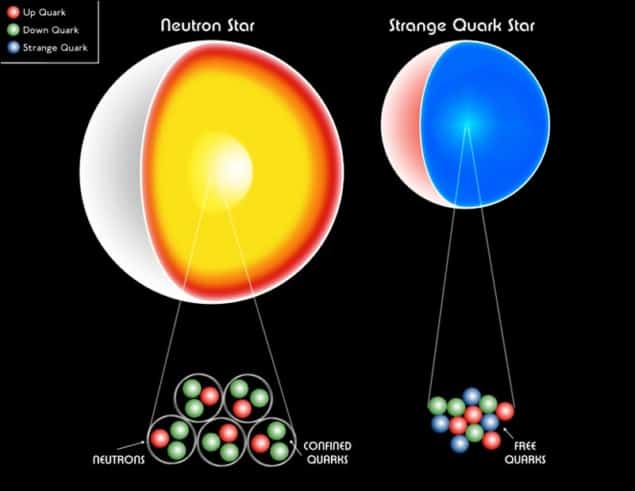
The energy needed to convert a neutron star into a so-called strange star may come from annihilating dark-matter particles. That is the conclusion of a new study by physicists in Spain, the UK and the US, who propose that this conversion mechanism may be a good way to put a lower limit on the mass of weakly interacting massive particles (WIMPs), a leading candidate for dark matter.
Once their nuclear fuel has burnt up, stars below a certain mass collapse to form neutron stars. These incredibly dense objects consist almost entirely of neutrons, the gravitational collapse having forced protons and electrons to merge. It has been proposed, however, that, given some kind of source of additional energy, neutron stars can convert to strange stars, objects consisting of strange matter – a soup of unbound up, down and strange quarks.
The idea is that adding this energy to a certain limited volume of the neutron star will unlock the up and down quarks confined inside the neutrons. Some of these quarks will then naturally convert into strange quarks, producing a region of strange matter known as a strangelet. If, as has been hypothesized, strange matter is in fact more stable than normal, nuclear, matter it will exist a lower energy. The excess energy given off by the conversion of normal matter into strange matter then unlocks more up and down quarks, leading to the creation of more strangelets.
A little energy is enough to transform a neutron star into a strange star Joseph Silk, University of Oxford
The result is a runaway process capable of converting an entire neutron star into strange matter within a second or less. “The neutron star is metastable, like someone on a mountain ledge,” explains Joseph Silk of the University of Oxford who was involved in the work. “Just as a little kick can push that person off the ledge and send them to the bottom of the mountain, so a little energy is enough to transform a neutron star into a strange star.”
Does strange matter exist?
While there is no clear evidence that strange matter actually exists, the observation of extremely brief but ultra-bright bursts of gamma rays from the cosmos suggests the existence of strange stars. Researchers have proposed that the enormous power needed to produce a gamma-ray burst could come from the formation of a black hole, but the large numbers of particles of normal matter surrounding a black hole could absorb much of that energy. The conversion of a neutron star into a strange star, however, could provide the required energy but without the surrounding matter.
However, that still leaves the question of where the neutron star gets its initial spark of energy. Some have suggested it simply comes from the energy of collapse or from very high-energy cosmic rays colliding with the star. Silk, however, points out that the former mechanism requires neutron stars to have a minimum mass and maintains that the latter mechanism is problematic because, he says, it would be unlikely to dump energy in the middle of the star, which is where it is needed to initiate the chain reaction.
Instead, Silk, Angeles Perez-Garcia of the University of Salamanca and Jirina Stone of the University of Tennessee, have calculated that annihilating WIMPs, which can accumulate in the centre of stars, could provide this energy. If confirmed, the mechanism would provide a new, independent lower limit for the mass of a WIMP. This is approximately 4 GeV (gigaelectronvolts), half of the minimum energy that the trio calculate is needed to initiate the neutron star conversion in this way (with each WIMP providing half of the mass-energy in each collision).
New way to find WIMPs
With direct, ground-based dark matter searchers able to go down to about 50 GeV, Silk says that this new approach could provide a useful complement to existing experiments. He points out that theory does not favour a WIMP mass of between 4 and 50 GeV but that a figure of about 10 GeV has been suggested by the recent, contested, results from ground-based detectors.
The team claims that two lines of observation could support their thesis and thereby help place a new limit on the mass of WIMPs. One would involve measuring the mass and radius of a strange star, obtained by studying the radiation of pulsars, and comparing these values with the predictions made by their model and those of alternative models. Evidence could also be obtained by creating and then measuring strangelets at the Relativistic Heavy Ion Collider in the US or in the Large Hadron Collider at the CERN laboratory near Geneva.
Paolo Gondolo of the University of Utah in the US believes that the new mechanism is plausible but has his doubts as to whether it could be used in the search for dark matter. “Even if a strange star is detected it might be hard to tell if it was formed by dark matter annihilation,” he says.
Cautious support for the dark-matter mechanism also comes from Dejan Stojkovic of the State University of New York in Buffalo, who says that this process “might be realized in nature”. But he maintains that the stability of the strange star in this scenario must be investigated. “If WIMP annihilation is too quick or too slow, the star may never reach thermodynamic equilibrium,” he says.
The work is described in Phys. Rev. Lett. 105 141101.



